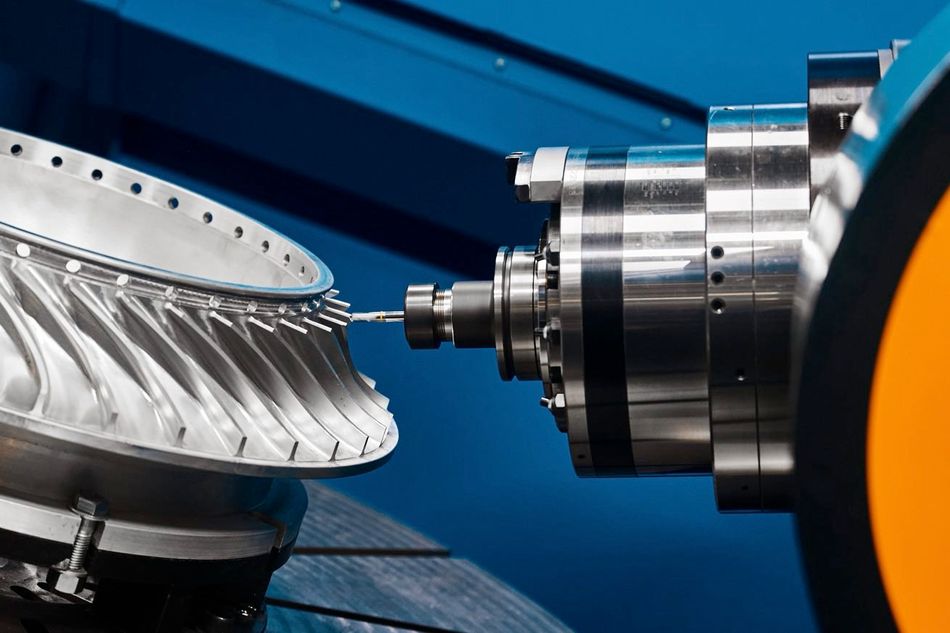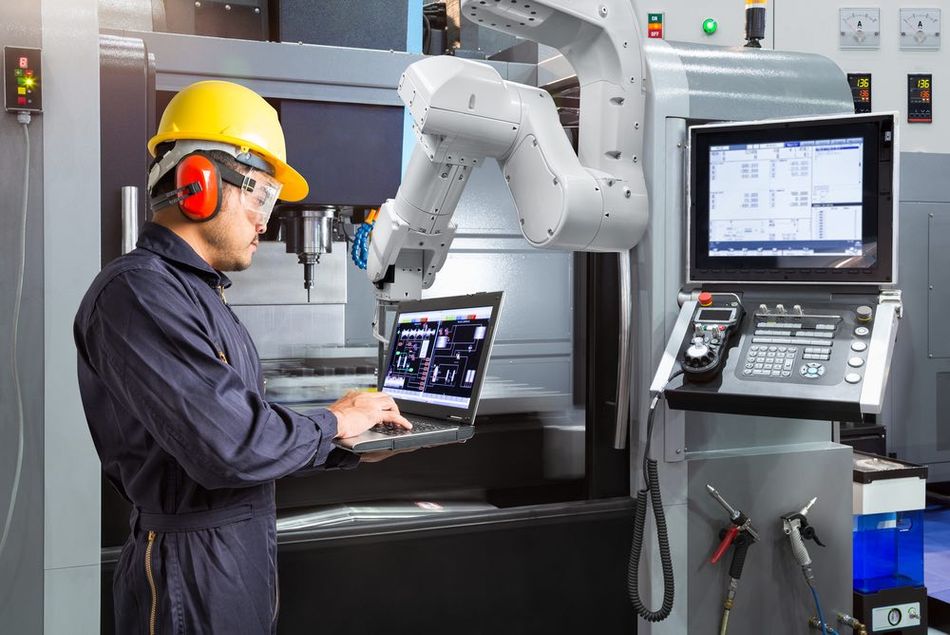CNC Programming: Mastering Precision and Efficiency in Engineering
The article consists of a comprehensive guide to understanding and applying CNC programming in modern engineering environments. Discover how when done right CNC programming transforms manufacturing processes, enhances precision, and optimizes production workflows.
CNC programming, a pivotal innovation rooted in the 1950s evolution of computer numerical control (CNC) in machinery, is a cornerstone of precision engineering. In short, CNC programming refers to the coding that controls the movements and actions of a CNC machine, instructing it how to cut, mill, or drill a material blank to form a finished product.
The coding language typically used in CNC programming, which guides the operation of factory tools and machinery with precise instructions, is known as G-code. The integration of CNC with modern technological advances like artificial intelligence and automated systems has not only streamlined production processes but also significantly enhanced the quality and efficiency of manufacturing outputs across industries such as automotive, aerospace, and electronics. As it continues to evolve, CNC programming increasingly supports complex, customized productions, meeting the growing demands for high precision and flexibility in manufacturing.
Brief Overview of CNC Machining
CNC machining refers to an automated production process in which various production tools are controlled by a computer and are used to selectively remove material from a workpiece to form a final component. It goes without saying then, that CNC machines come in various forms, each designed for specific tasks and applications. The primary CNC machining tools include mills, lathes, drills, and routers. Let’s take a quick look at some of these functions.
Mills
Milling machines are equipped for heavy-duty cutting operations with precision. They can handle a wide range of materials, from plastics to metals, shaping complex geometrical forms. Key components such as high-speed spindles, multi-axis movement capabilities, and automated tool changers enable advanced CNC milling operations, to achieve detailed and intricate designs.

Lathes
CNC lathes, also known as CNC turning, excel in producing symmetrical objects by rotating the workpiece against a fixed cutting tool. They typically feature robust control systems, precision spindles, and live tooling capabilities that allow for both turning and milling operations, thereby increasing versatility and efficiency.
Drills
As the name suggests, CNC drilling leverages various sizes and types of drill bits to form holes in a workpiece. This CNC function is typically used in combination with others to facilitate part assembly. Using CNC programming to control the drill ensures complete accuracy for hole diameter, placement, and depth.
Routers
CNC routers are primarily used for cutting softer materials like wood, composites, aluminum, and plastics. Routing is used in woodworking and sign making, offering speed and accuracy with components designed for rapid traversal and detailed carving tasks.
Advanced Features
In each of these CNC functions, advancements such as automated tool calibration and error compensation technologies are becoming increasingly standard. These features ensure ongoing precision throughout the operation, even under variable conditions. Automated calibration minimizes downtime by quickly setting tools to exact specifications, while error compensation mechanisms adjust operations in real-time to avoid defects and maintain quality.
Recommended reading: What Is CNC Machining? The Complete Basics to Get Started
G-Code: The Core of CNC Programming
Computer numerical control programming ensures unparalleled precision and efficiency in automated machine tool operations. Central to this process are G-code and M-code, programming languages that direct every precise movement of a machine’s tools, from cutting paths to tool changes. From a user perspective, CNC programming code is typically generated automatically using CAD/CAM software, which converts part designs and geometries into G-code instructions that the CNC machine can understand. That said, it is still helpful to understand CNC programming basics in order to adjust code when necessary or troubleshoot any issues that may arise.
G-code and M-code’s functions
G-code programming governs the machine paths, specifying where to move, at what speed, and in what sequence. It is crucial for tasks that require high precision, such as drilling minute components in aerospace engineering or creating intricate designs in consumer electronics. M-code, for its part, manages the ancillary machine functions that support these movements, like turning coolant on or off, which is essential for maintaining the optimal temperature during metal fabrication to prevent material warping.
The algorithms that interpret and execute G-code play a critical role, transforming digital designs into precise physical actions. This translation from code to action involves a detailed sequence of steps, ensuring each part of the toolpath is executed flawlessly to maintain the tight tolerances required in sectors like automotive manufacturing, where even a millimeter of deviation can result in faulty assemblies.
Common commands, which illustrate the level of control and precision that can be achieved in CNC programming, include the following:
G01 | Linear movement |
G02 and G03 | Circular interpolation |
M03 | Start the spindle clockwise |
M05 | Stop the spindle |
M08 | Activate the coolant |
M09 | Deactivate the coolant |
There are also other types of CNC programming code that are good to know. For example (T) dictates a tool change, while (F) sets the feed rate (i.e. the speed at which a cutting or drilling tool moves through the workpiece) and (S) controls the spindle speed in rotations per minute (rpm). (X), (Y), and (Z) commands indicate coordinates, ensuring that the tool is machining the exact right part of the workpiece.
Recommended reading: Your Guide to 3D Printing G-Code
Recent Developments in CNC Programming
The landscape of CNC software has experienced transformative advancements, particularly influenced by the broader manufacturing trends towards automation and increased customization. These software developments are integral to the evolving needs of Industry 4.0, which emphasizes interconnected and intelligent manufacturing systems.

Predictive Maintenance
Software advancements such as predictive maintenance are pivotal in this context. By incorporating machine learning algorithms, CNC systems can predict potential failures before they occur, significantly reducing downtime and maintenance costs. This capability is critical in today’s fast-paced production environments where even minor disruptions can lead to substantial financial losses.
Complex Pattern Programming
The demand for customization and precision in manufacturing has driven significant improvements in complex pattern programming. Tools such as Autodesk Fusion 360 and Mastercam now facilitate the creation of intricate designs that were once considered too challenging or time-consuming. These tools support the detailed work required in industries like aerospace and consumer electronics, where precision is paramount.
Integration with Smart Manufacturing
These software suites are not just standalone tools but part of a larger ecosystem that includes data analytics and integration capabilities. For example:
Siemens SINUMERIK is celebrated for its integration capabilities, enabling better data analytics and machine efficiency.[1]
Autodesk Fusion 360 excels in collaborative projects, thanks to its cloud-based platform which ensures that updates and collaboration are seamless.[2]
Mastercam provides robust simulation capabilities, essential for validating the machining process before actual production commences.[3]
Such integrations embody the principles of smart manufacturing, ensuring that CNC technologies not only meet current manufacturing needs but are also scalable and future-proof. This alignment with Industry 4.0 technologies enables manufacturers to remain competitive in a rapidly evolving industry landscape.
Machining learning
The adoption of machine learning (ML) in CNC systems is transforming manufacturing, pushing the boundaries of what automated systems can achieve in terms of efficiency and precision. This shift is part of the broader trend towards intelligent manufacturing, where data-driven decisions optimize every aspect of production from tool wear to quality control.
Machine learning algorithms, such as neural networks and decision trees, analyze vast amounts of operational data to foresee machine behavior and process outcomes. This capability extends beyond predictive maintenance to encompass process optimization and quality assurance, significantly reducing waste and improving product consistency.
Technical Integration of ML in CNC The integration process involves several stages:
Data Collection: Embedded sensors in CNC machines gather real-time operational data.
Model Training: Data is analyzed to train ML models that predict and adapt to changes in machine conditions.
Real-Time Implementation: Once deployed, these models adjust machine operations dynamically, enhancing both the accuracy and efficiency of the manufacturing process.

Practical Applications and Real-World Impact
CNC programming has become integral in industries like automotive and aerospace by enhancing efficiency and precision. Its evolution over decades—particularly increased automation—has brought forth significant advancements in production techniques, markedly improving the efficiency of manufacturing.
The automotive industry has seen transformative changes with CNC programming and CNC machining, especially in the production of complex engine components and intricate body panels. Advanced CNC techniques, such as multi-axis machining, not only ensure components meet stringent specifications but also reduce material waste and energy consumption significantly.
Similarly, the aerospace sector relies heavily on CNC machining for manufacturing critical components like turbine blades and fuselage panels. The precision required for these parts is paramount, where even minor deviations can compromise safety. Adaptive machining techniques, a staple in modern CNC systems, adjust parameters in real-time to adapt to material inconsistencies, enhancing product reliability and reducing carbon emissions from less frequent replacements and repairs.
CNC machining is also a well established process for manufacturing precision tools to facilitate mass production processes like injection molding. CNC machining offers the necessary tolerances to produce high-quality molds from robust materials like tool steel and stainless steel which can withstand the pressures and repeated use of injection molding. More recently, CNC machining has also been used in combination with additive manufacturing (3D printing) to transform net-shaped parts into precision end-use components.
Recommended reading: CNC Machining Materials: Choosing the Right Materials for CNC Machining Project
Enhancements in Production Quality and Efficiency
CNC programming has significantly reshaped manufacturing landscapes, not just by enhancing efficiency and precision but by aligning with global manufacturing trends towards greater customization and adaptability to rapid product life cycles. This shift has enabled industries to respond quickly to market demands and incorporate complex designs and new materials with ease.
Advanced CNC programming techniques allow manufacturers to handle diverse materials and intricate designs, ensuring that production processes are not only faster but also more reliable. This precision is crucial in sectors like automotive and consumer electronics, where the demand for customization and high-quality output is constantly increasing.
Production Enhancements
Design Integration: CNC systems integrate seamlessly with CAD software, ensuring that specifications translate directly into precise machining instructions.
Material and Tool Adaptability: Sophisticated CNC setups adjust parameters dynamically to accommodate varying material properties, enhancing both tool life and product quality.
Optimized Tool Paths: Algorithms now not only plan efficient cuts but also adapt in real-time to changes in material texture or integrity, minimizing waste and improving speed.
Quality Assurance: Embedded sensors and real-time diagnostics check and adjust the machining process, ensuring that each product meets strict quality standards.
Final Inspection and Feedback: Automated systems perform final checks and feed data back into the design system, allowing for continuous improvement in both design and production phases.
By integrating these advanced CNC techniques, manufacturers not only boost operational efficiency but also significantly enhance the quality of the output, catering to the evolving needs of a dynamic market. The ongoing development of CNC technologies promises to further elevate manufacturing capabilities, driving the future of industrial production towards even greater heights of innovation and efficiency.
Common CNC Programming Challenges
Even as CNC programming has evolved, there are still challenges that can affect production efficiency and quality. Understanding the root causes and impacts of these challenges is essential for developing effective strategies to overcome them.
Code Errors and Machine Calibration Issues
Code errors are a relatively common issue in CNC programming, often arising from incorrect syntax or logical mistakes in the programming process. These errors can lead to machine malfunctions or defective parts, causing disruptions in production. Machine calibration is equally critical; even minor misalignments can result in substantial deviations from desired specifications. For instance, a miscalibrated machine might produce parts that do not fit correctly in an assembly, leading to increased scrap rates and production delays.
Multi-Axis Synchronization
The complexity of modern CNC machines, which often incorporate multiple axes, introduces synchronization challenges. Proper coordination between these axes is vital for executing intricate designs accurately. Misalignment or timing errors can lead to product defects, increased wear on the machine, or even complete failure. For example, in the aerospace industry, the precise synchronization of multi-axis CNC machines is crucial for producing components with tight tolerances.
Material Handling
Handling a variety of materials with different properties adds another layer of complexity and requires specific parameters and CNC machine programming. Each material may require specific adjustments in speed, tooling, and approach angles and advanced materials like composites or high-strength alloys may need specialized programming to handle their unique characteristics to avoid material damage and ensure structural integrity.
Practical Solutions and Best Practices
To address these challenges, CNC programmers can adopt several best practices:
Regular Training and Updates: Staying updated with the latest CNC software and programming techniques helps prevent and quickly identify any errors in the code.
Routine Calibration: Implementing a regular calibration schedule ensures machines operate within precise specifications, maintaining product quality.
Advanced Simulation Tools: Utilizing simulation software to preview machine operations can identify and correct synchronization issues before actual production.
Material-Specific Programming: Tailoring programming parameters to each material type can mitigate handling issues, ensuring optimal performance and quality.
By incorporating these strategies, CNC programmers can enhance machine performance, reduce downtime, and ensure high-quality production outputs. Understanding and addressing these common challenges is crucial for leveraging the full potential of CNC technology in modern manufacturing.
Conclusion
Modern CNC programming has transformed manufacturing and engineering, evolving from largely manual programming to highly automated computer-integrated processes. This technology has enabled unparalleled precision and efficiency, transforming industries like automotive and aerospace.
The ability to produce complex geometries with exacting tolerances has opened new possibilities for innovation and quality. Furthermore, CNC programming's integration with AI and machine learning continues to push the boundaries of automation and intelligence in manufacturing. Mastering CNC techniques offers significant practical benefits, including enhanced product quality, reduced waste, and increased production speeds, making it an indispensable skill for modern engineers and manufacturers.
FAQs on CNC Programming
Q: What is CNC programming?
A: CNC programming refers to the process of converting computer-aided design (CAD) models into manufacturing instructions legible by computer numerical control (CNC) systems. 3D models are exported into a coding language (including G-code and M-code) which tell the CNC machine what tools to use and give step-by-step instructions on how to create a specific geometry. While CNC programming is today largely automated, manual CNC programming is still useful to CNC operators for making adjustments for complex parts and troubleshooting issues.
Q: What is G-code in CNC programming?
A: G-code is the language used in CNC programming to instruct machines on how to perform specific tasks. It consists of commands that control the movement, speed, and path of the machine's tools. By translating designs into precise instructions, G-code ensures accurate and efficient manufacturing of parts.
Q: How does CNC programming interface with other manufacturing technologies?
A: CNC programming interfaces seamlessly with various manufacturing technologies, creating an integrated workflow that enhances overall productivity. For example, CAD software is used to design parts, which are then translated into CNC programs using CAM (Computer-Aided Manufacturing) software. This integration ensures that the design intent is accurately conveyed to the CNC machine. Additionally, CNC systems often work alongside automation technologies such as robotic arms for material handling and assembly, further streamlining the manufacturing process. In a smart factory setting, CNC machines communicate with other systems to adjust operations dynamically based on real-time data.
Q: What are the future trends in CNC programming technologies?
A: The future of CNC programming is set to be shaped by advancements in AI and machine learning, which will bring greater automation and intelligence to machining processes. Predictive maintenance, enabled by AI, will minimize downtime by anticipating machine failures before they occur. Machine learning algorithms will optimize toolpaths and cutting parameters dynamically, leading to more efficient machining and higher quality outputs.
Q: What is conversational programming?
Conversational programming in CNC machining simplifies the creation of machine instructions by using plain language prompts and interactive screens. This user-friendly approach eliminates the need for complex coding, allowing operators to input machining parameters directly, streamlining setup, reducing errors, and enhancing productivity for both novice and experienced users. In other words, the machining instructions are generated by the machine tool’s programming rather than imported from an external program.[4]
Q: Can 3D printing and CNC machining be used together?
A: Yes, advances in additive manufacturing (3D printing) are expected to integrate more closely with CNC machining, providing hybrid manufacturing solutions that combine the best of both worlds. For instance, hybrid machines that combine subtractive and additive processes will enable manufacturers to create parts with complex internal structures possible thanks to additive technologies with the precise tolerances of CNC machining.
References
[1] Boosting productivity in CNC production [Internet]. Siemens, 2024. Available from: https://www.siemens.com/global/en/products/automation/systems/cnc-sinumerik.html
[2] Modern CAM software for CNC machining [Internet]. Autodesk, 2024. Available from: https://www.autodesk.com/products/fusion-360/cnc-machining
[3] Creating software and services that solve the world's manufacturing challenges [Internet]. Mastercam, 2024. Available from: https://www.mastercam.com/
[4] Hasan MA. Computer numerical control machines: An account of programming methods and techniques. Computer. 2015;3(7):9.
Table of Contents
Brief Overview of CNC MachiningMillsLathesDrillsRoutersAdvanced Features G-Code: The Core of CNC ProgrammingG-code and M-code’s functionsRecent Developments in CNC ProgrammingPredictive MaintenanceComplex Pattern ProgrammingIntegration with Smart ManufacturingMachining learning Practical Applications and Real-World ImpactEnhancements in Production Quality and EfficiencyProduction EnhancementsCommon CNC Programming ChallengesCode Errors and Machine Calibration IssuesMulti-Axis SynchronizationMaterial HandlingPractical Solutions and Best PracticesConclusionFAQs on CNC ProgrammingReferences
